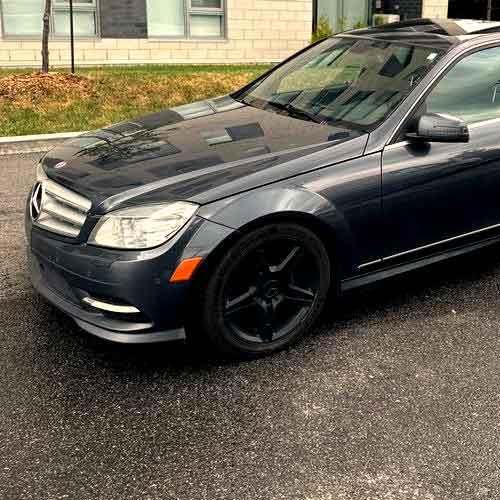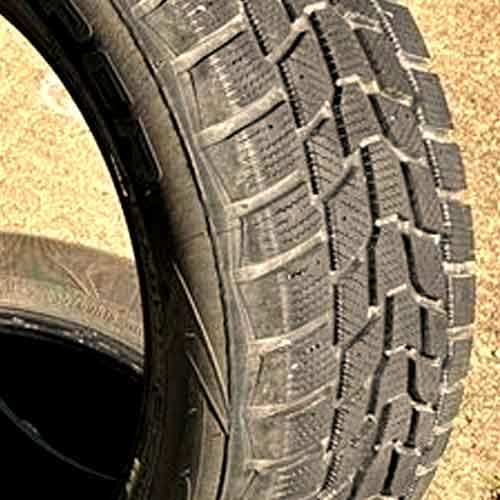In the clash of winter tire titans, Cooper Evolution Winter and the Mastercraft Glacier Trex, each showcasing distinct strengths, are set to compete. But who will emerge as the ultimate winter champion? Let’s dive in and find out!

Table of Contents
Key Takeaway
- Wet Traction: Cooper Evolution Winter wins on grip, Glacier Trex is superior in hydroplaning resistance.
- Dry Traction: Cooper’s boy leads in grip and handling.
- Snow Performance: Glacier Trex holds a slight edge.
- Tread Life: Advantage goes to Cooper’s tire due to lighter weight and stiffer compound.
- Ice Performance: Glacier Trex provides shorter braking distances and superior acceleration.
- Comfort Levels: Cooper’s tire provides a quieter ride, while Glacier Trex excels in shock absorption.
- Fuel Economy: Cooper Evolution Winter has less rolling resistance, leading to better fuel efficiency.
Sizes Info
The Cooper Evolution Winter comes in 67 sizes in 14 to 20 inches, having following specs.
- Speed ratings: T and H.
- Load ratings: SL or XL.
- Tread depth: 12 and 14/32″.
- Weight: 17 to 37 lbs.
- Tread warranty: None.
On the other side, the Mastercraft Glacier Trex comes in 14 to 18″ with following.
- Speed ratings: H and T.
- Load ratings: SL and XL.
- Tread depth: 12 and 14/32″.
- Weight: 15 to 40 lbs.
Dry Traction
Dry traction consists of directional grip and handling.
Directional Grip
The Cooper Evolution Winter excels in directional, or dry grip due to its slightly wider continuous central rib, and ability to stay firm on road.
This ensures an unbroken, and a better connection between the rubber and the road surface, resulting in superior braking distances.
On the other side, the wider tread voids of the Mastercraft Glacier Trex, compromise its ability to provide a similar contact patch, leading to reduced directional grip.
Handling
The Cooper Evolution Winter tire demonstrates superior sideways traction and cornering abilities due to its closed-up pattern.
The tire’s lighter weight prevents excessive flexing and bending of the shoulder lugs during cornering, resulting in a more responsive steering feel.
On the other hand, the Mastercraft Glacier Trex tire’s heavier structure and wider grooves lead to longer handling lap times.
The bending of the shoulder lugs affects the over and under steering balance, causing a delayed steering response.
Though note that most bending of the lugs is done because of the tire softer rubber, rather than weight (as difference is low between them).
Wet Traction
The performance of a tire on wet surfaces depends primarily on two factors: the design of the tread and the rubber compound used. These factors determine the tire’s grip and resistance to hydroplaning.
Wet Grip
When it comes to wet grip, the Cooper Evolution Winter tire takes the lead. It incorporates a more aggressive siping design that consists of a comprehensive array of rectilinear and interlocking slits, within the tread (as you go deep)
These sipes work by drawing in water particles, allowing the tire to grip the slightly dried surface more effectively.

In contrast, the Mastercraft Glacier Trex is not only missing with aggressive siping like the Cooper, but it also features a less flexible tread compound.
So sipes, which have to flex and suck in water particles, aren’t able to function fully, resulting in longer braking distances and handling times on wet surfaces.
Hydroplaning Resistance
Hydroplaning is a phenomenon in which water prevents the tire from maintaining proper contact with the road surface, leading to a loss of traction.
And here the Mastercraft Glacier Trex tire excels in hydroplaning resistance.
This is because, relatively, the tire features slighlty more broader grooves and tread voids, which enable higher average float speeds in both curved and straight aquaplaning tests.
And yes combined with that are the interconnected web of grooves which more efficiently disperses water in all directions, providing superior hydroplaning resistance.
On the other hand, the Cooper Evolution Winter tire lacks proper sideways water removal capabilities, mainly due to its longitudinal rib in the very middle.
This can result in longer braking distances and handling times on wet roads compared to its counterpart.
Tread Life
Tread life is influenced by rolling resistance, which is determined by the tire’s weight and rubber composition.
The Mastercraft Glacier Trex tire falls short in this aspect due to its heavier weight and more spaced-apart lugs.
The increased weight places additional stress on the tread, resulting in accelerated wear, while the tire’s relatively softer rubber compound further contributes to that, shortening tread life.
On the flip side, the Cooper Evolution Winter tire holds an advantage in tread life as it is lighter. features a more streamlined lugs pattern, and has a stiffer rubber compound.
So its lugs experience less friction with the road surface, and at the same time, aren’t that prone to burning to begin with.
Snow Performance
Both tires perform well on fluffy snow, but the Mastercraft Glacier Trex tire has a slight advantage.
Its tread design includes a more voided up pattern, so you get bigger in-groove notches.
These notches trap snow particles and facilitate better snow-to-snow contact, while the bigger sweeping lugs efficiently displace heavy snow, aiding forward moving inertia.
In contrast, the Cooper Evolution Winter tire falls behind in snow performance. Its sealed/crowded tread pattern with narrower in-groove notches does not provide as much snow contact, with its lodged snow.
This is very much needed as snowflakes have unique arms, which very much like to interlock with each other. So you get superior friction, in case of snow to snow contact, compared to snow to rubber.
Ice Performance
On icy terrain, the Mastercraft Glacier Trex provides slightly shorter braking distances and superior acceleration due to its numerous biters spread across the tread.
This is because the tire carries a lot more biters.
If you look at both tires, you’d note that the Mastercraft, holds more aggressive snow vices, chamfered edges, and a combination of rectilinear and interlocking siping.
All these factors really contribute to better overall traction.
In comparison, the Cooper’s tire with its missing dual siping design, and chamfered edges takes the back seat.
Though using studs on both tires makes them perform almost identically.
Fuel Economy
Fuel efficiency is closely tied to a tire’s traction and structural weight.
And let me say that the Mastercraft Glacier Trex could use some help here.
I mean, its relatively greater weight and tread voids, combined with its softer tread compound, cause a very increased lug bending during cornering, braking, and acceleration, resulting in higher energy expenditure, which of course has to come from fuel.
On the other side, the Cooper Evolution Winter, with its streamlined, longitudinally aligned ribs, experiences less rolling resistance.
Its tread compactness minimizes energy waste by reducing block flexing, focusing the energy on tire rolling.
Comfort Levels
Tire comfort is determined by factors such as road noise and vibration absorption, influenced by the tire’s construction, materials, tread pattern, and sidewall design.
The Cooper Evolution Winter tire excels in noise reduction due to its smaller tread voids, resulting in a quieter ride. This is mainly due to the tire’s superior pitch sequencing technology, where in-groove resonance is minimized.
On the other side, the Mastercraft Glacier Trex performs better in terms of bump absorption due to its relatively softer tread compound, which effectively absorbs shocks.
Conclusion
To conclude, the Mastercraft Glacier Trex tire excels in snow and ice performance and along with resistance to hydroplaning.
However, the Cooper Evolution Winter demonstrates superior performance in wet and dry conditions.
Additionally, this tire offers advantages in terms of fuel economy, tread life, and noise reduction, too.
Though in case of bumps absorption, the Mastercarft stays unbeatable.
So there you go guys, which one would you choose?